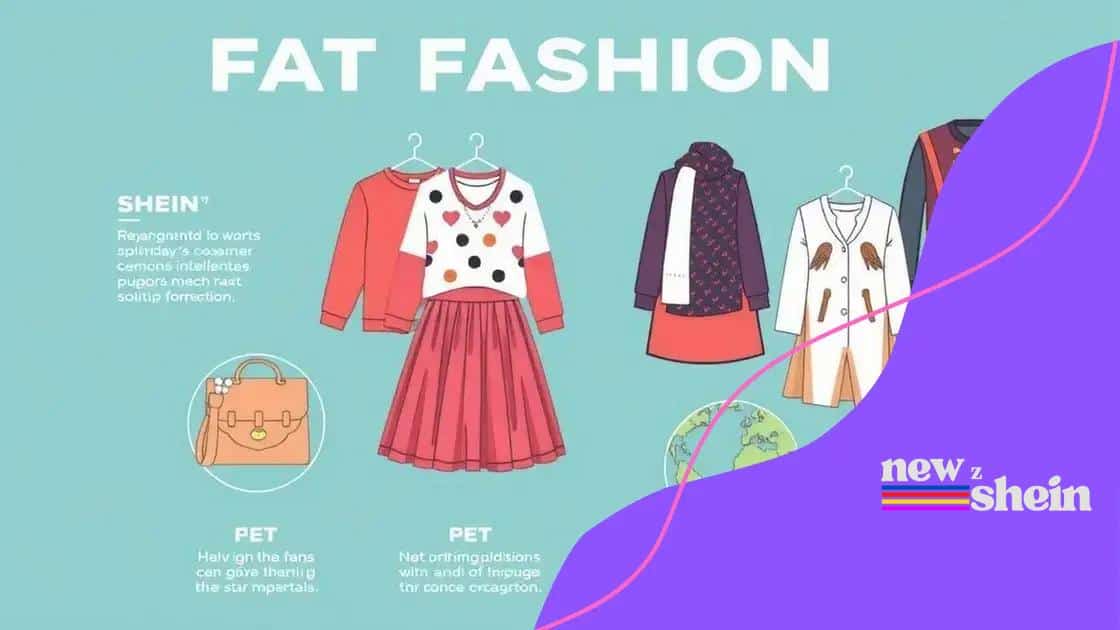How Shein promotes awareness about fast fashion impacts

How Shein promotes awareness about fast fashion impacts through educational campaigns, social media engagement, and community initiatives encourages consumers to make informed choices that support sustainable practices.
How Shein promotes awareness about fast fashion impacts is a pivotal topic in today’s consumer culture. With growing concerns over sustainability, brands like Shein are navigating their role in leading discussions and sparking awareness about more mindful consumerism.
Understanding fast fashion’s influence
Understanding the essence of fast fashion is crucial to grasp its impact on our world today. This industry thrives on speed and low costs, often at the expense of ethical considerations. But what does this mean for consumers and the planet?
The characteristics of fast fashion
Fast fashion is characterized by rapid production cycles, offering the latest trends at affordable prices. However, this comes with significant downsides, including:
- Overproduction of clothing, leading to waste.
- Exploitation of workers in low-wage countries.
- Increased pollution from textile manufacturing.
This model encourages consumers to buy more, wear less, and discard clothing quickly. As a result, our purchases reflect not only personal taste but also a broader environmental and ethical concern.
Shifting consumer perspectives
More people are starting to recognize the influence of fast fashion. Awareness is growing, leading consumers to seek brands that prioritize sustainability. This change is essential for promoting responsible consumption.
Consumers are now more curious about the origins of their clothing. They want to know about the production processes and the impact their choices have on the world.
These shifts are prompting brands like Shein to reconsider their strategies. As they face pressure to adopt more sustainable practices, they also engage their customers in conversations about ethical consumption.
How Shein raises awareness campaigns
Understanding how Shein raises awareness campaigns is important in today’s fast fashion landscape. The brand leverages its massive reach to educate consumers about the impacts of fast fashion and promote sustainable practices.
Utilizing social media platforms
Shein actively engages with audiences on platforms like Instagram and TikTok. These platforms allow them to share informative content and create discussions around fashion sustainability. The visually appealing posts and videos resonate well with younger consumers, sparking interest in ethical shopping.
- Highlighting influencers who support sustainability.
- Sharing tips on recycling and upcycling clothing.
- Promoting minimalism in fashion choices.
By aligning with eco-conscious influencers, Shein amplifies its message and reaches a broader audience. These efforts encourage consumers to think critically about their purchases and their effects on the environment.
Collaborations and initiatives
Partnerships with non-profits and environmental organizations are another way Shein raises awareness. Collaborating on campaigns focused on sustainability and responsible consumption fosters a sense of community. Through these initiatives, Shein supports vital causes while showcasing its commitment to change.
Educational campaigns often include clear, engaging visuals and thought-provoking messages. As a result, consumers become more aware of their shopping habits and the broader implications of fast fashion.
Consumer education on sustainable practices

Consumer education on sustainable practices is essential in the fight against the negative impacts of fast fashion. Many consumers are unaware of how their shopping choices affect the environment. By raising awareness, brands and individuals can encourage more responsible consumption.
The importance of education
Understanding sustainable practices helps consumers make better decisions. Education can cover a range of topics that highlight the implications of fast fashion:
- Environmental damage caused by clothing production.
- The social issues related to garment workers.
- The benefits of choosing sustainable materials.
When consumers are informed, they are more likely to support brands that prioritize ethical practices. This shift in demand can lead to more companies adopting sustainable methods.
Methods of educating consumers
Various platforms and initiatives play a key role in educating shoppers. Online workshops, informative articles, and social media campaigns can provide valuable insights. Visual content, like infographics and videos, can simplify complex information.
Engaging consumers with fun challenges, such as clothing swaps or upcycling contests, fosters a community around sustainability. These activities encourage sharing ideas and tips on how to shop mindfully. Moreover, influencers can help spread the message effectively, reaching diverse audiences.
As consumers learn more about the sustainable practices available to them, they can make choices that positively influence the planet. These small changes, when adopted widely, can lead to significant improvements.
The environmental cost of fast fashion
The environmental cost of fast fashion is significant and often overlooked. This industry prioritizes speed and low prices, leading to serious consequences for our planet. From excessive water use to pollution, the impacts are profound.
Water consumption and pollution
Fast fashion requires enormous amounts of water for production. For example, creating a single cotton shirt can consume over 2,700 liters of water. This resource-intensive process can lead to water shortages in regions where it is needed most.
- Pesticides used in cotton farming can contaminate local water sources.
- The dyeing process often releases toxic chemicals into rivers.
- Microplastics from synthetic fabrics end up in oceans, harming marine life.
These issues highlight the need for greater awareness among consumers about the water footprint of their clothing.
Waste generation
Another serious concern is the waste generated by the fast fashion model. The rapid production cycle leads to millions of clothing items being discarded each year. Many of these garments end up in landfills, where they can take decades to decompose.
Additionally, the quality of fast fashion items is typically lower, leading to a shorter lifespan. This results in more frequent purchases, creating a cycle of waste that is hard to break.
By understanding the environmental cost associated with fast fashion, consumers can make more informed choices. Opting for sustainable brands or second-hand clothing can reduce the overall impact.
The role of social media in promoting change
The role of social media in promoting change is significant, especially in the context of fast fashion. Platforms like Instagram, TikTok, and Twitter have become powerful tools for spreading awareness and driving conversations around sustainable fashion.
Connecting communities
Social media connects individuals passionate about sustainability. These platforms allow users to share their experiences, ideas, and tips on ethical shopping. This exchange fosters a community where everyone can contribute to the conversation.
- Hashtags such as #SustainableFashion help organize posts.
- Users can follow influencers who promote eco-friendly brands.
- Engaging content, like videos and graphics, captures attention and educates.
By following these trends, users can stay informed about the latest movements in sustainable fashion.
Encouraging brand accountability
Social media holds brands accountable for their practices. Customers now demand transparency about how and where their clothes are made. Brands that don’t adhere to ethical standards risk public backlash.
Consumers can share their concerns, leading to discussions that prompt companies to change their practices. The visibility of these dialogues can encourage brands to adopt more sustainable methods, knowing they are being watched by their audience.
Furthermore, successful social media campaigns can lead to significant changes in brand policies, illustrating the power of collective voices. As social media continues to evolve, its role in promoting change in the fast fashion arena will undoubtedly grow.
FAQ – Questions About Fast Fashion and Sustainability
What is fast fashion?
Fast fashion refers to inexpensive clothing produced rapidly by mass-market retailers in response to the latest trends.
How does fast fashion impact the environment?
Fast fashion contributes to pollution, excessive waste, and resource depletion, significantly harming the environment.
What can consumers do to promote sustainability in fashion?
Consumers can choose sustainable brands, shop second-hand, and educate themselves about the environmental impacts of their purchases.
What role does social media play in raising awareness about fast fashion?
Social media helps connect communities, promotes discussions, and holds brands accountable for their practices in the fashion industry.





